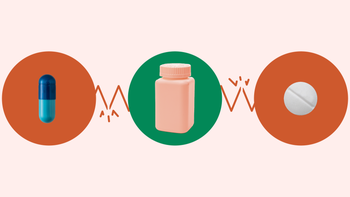
Pulmonary Embolism (Blood Clot in the Lung): Treatment and Recovery
Key takeaways:
The main treatment for a blood clot in your lungs (called a pulmonary embolism) is taking anticoagulant medications (blood thinners). Some people will also need additional treatments to break up the clot, but this is less common.
Most people will take anticoagulants for 3 months. Some people will take them for longer periods of time or even for life. This depends on their risk for future blood clots.
Treatment for a pulmonary embolism helps prevent serious complications. These problems can include heart failure, low oxygen levels, or pulmonary hypertension — a condition that can permanently affect your lung and heart function.
Access savings on related medications
Table of contents

A pulmonary embolism (PE) is a blood clot that has traveled to your lungs. Getting the right treatment for a PE is important, because the condition can lead to life-long complications or even death.
The type of treatment depends on the size of your clot, where it’s located in your lungs, and how much it affects your heart and lungs. Keep reading to learn more about the treatment of this condition and what to expect if you or someone you know has a PE.
What’s the treatment for a pulmonary embolism?
The main treatment for PE is medication that helps thin your blood so that the clot eventually dissolves. But in some cases — when the clot is very large or immediately life-threatening — additional medications or procedures may be needed to break it up right away. We review all of these below.
Medications for pulmonary embolism
The most common treatment for PEs is anticoagulants, more commonly known as blood thinners. These medications work by interfering with your blood’s ability to clot. They don’t break up the existing clot right away. Instead, they stop the clot from getting bigger. This gives your body the chance to slowly dissolve the clot over time.
Common anticoagulant options are:
Direct-acting oral anticoagulants: Medications like apixaban (Eliquis) and rivaroxaban (Xarelto) are the preferred blood thinner. They don’t need frequent blood tests for monitoring. And they have a lower risk of causing bleeding compared to coumadin.
Warfarin (Coumadin): This is one of the oldest anticoagulants. Warfarin requires that you monitor your blood levels. But it can be easily reversed, so it might be a good choice for someone who is at a higher risk of bleeding.
Lovenox (Enoxaparin): This is given as an injection into your skin. Sometimes people use it for a short period of time while they transition to warfarin. It’s also safe to use during pregnancy.
Is it leg cramps or a blood clot? Many blood clots in the lung come from clots that start in your legs. Learn about the early warning signs.
What does a blood clot feel like? Blood clots can cause a wide range of symptoms. People share their different experiences.
Can you exercise while taking blood thinners? Yes. In fact, exercise is an important part of recovery after a blood clot. A cardiologist explains how to exercise safely.
Procedures
In some cases, people with PEs need treatments that break up the blood clot immediately. This is sometimes necessary if the blood clot is particularly large or putting a lot of pressure on your heart or lungs.
When this is the case, healthcare teams can break up a blood clot with:
Fibrinolytics: These are strong intravenous (IV) medications that break apart any existing blood clots (rather than prevent further clotting). Examples include tissue plasminogen activator (tPA) and tenecteplase. Compared to anticoagulants, they have a higher risk of bleeding complications.
Catheter-directed lysis: In this procedure, a trained professional threads a catheter through your veins to reach the clot. Then, they administer the fibrinolytic medication directly onto the clot. This helps to decrease bleeding risk because less medication is needed.
These treatments are usually only used in very serious cases because they carry a higher risk of life-threatening bleeding.
How long is the recovery time for a blood clot in the lungs?
After you start treatment for a PE, it will likely take at least a few days before you begin to feel better. You’ll gradually feel better as your body slowly breaks down the blood clot. The good news is that you can return to your normal daily activities once treatment begins (if your symptoms allow). It’s also safe to exercise while taking blood thinners.
Recovery from a PE depends on the treatment approach and the size of the blood clot. A larger blood clot will take longer to dissolve. But these are also the types of clots that might require fibrinolytics (which break down the clot right away). So, this could accelerate the recovery.
Most people will need to take blood thinners for at least 3 months. Some may need them longer, or even for the rest of their life if they have a medical condition that permanently increases their risk for blood clots. Long-term treatment might also be needed if someone has had more than one blood clot or PE.
After starting treatment, it’s important to closely follow up with your healthcare team. If your symptoms improve and don’t come back, you might not need more testing. But if symptoms continue, you might need testing to check on the clot or to look for possible complications related to the PE.
What’s the prognosis for a blood clot in the lung?
The prognosis of blood clots in the lung depends on the size of the clot. Most PEs are small and not life-threatening. With treatment, most people will make a full recovery.
There are some potential long-term complications of blood clots. About 1 in 30 people who get a blood clot will develop a condition called “pulmonary hypertension.” This is essentially high blood pressure of the arteries in your lungs. This condition can lead to chronic shortness of breath as well as heart failure.
Large blood clots are much more serious and can be life-threatening. This is because they interfere with the vital function of the heart and lungs, which may lead to organ failure. But these types of PE aren’t common. Less than 2% of PEs that are treated are fatal.
Both prognosis and fatality rates are higher in people who don’t receive treatment for PE. If you have new symptoms or think you might have a blood clot, reach out to a healthcare professional.
Frequently asked questions
The symptoms of a pulmonary embolism can include:
Shortness of breath
Chest pain, particularly when taking a deep breath
Lightheadedness, dizziness, or fatigue
Bloody mucous
Rapid heart rate
It can take several weeks to a few months for a blood clot to fully go away. This depends on the size of the clot, how much blood flow is getting to the area, and the specific treatment approach.
Most of the time, a pulmonary embolism won’t cause permanent damage to your lungs. In rare cases, people will develop a condition called pulmonary hypertension. This causes elevated blood pressure in the arteries of your lung. This affects blood flow through your lungs and can lead to long-term shortness of breath or even heart failure.
Yes, you can have a pulmonary embolism and not know it. Not all blood clots cause symptoms. The absence of symptoms is more common in very small pulmonary emboli that aren’t life-threatening. But this is rare. Most people with a PE big enough to need treatment will have at least mild symptoms.
Not everyone with a pulmonary embolism needs to stay in the hospital. This varies according to your condition. If you’re otherwise healthy and the clot is small and not affecting your heart, you may be able to start treatment at home with blood thinners and follow up with your healthcare team.
You’ll likely need a short hospital stay if you have:
A preexisting heart or lung condition
A particularly large blood clot
Low oxygen levels or you feel significantly short of breath
Treatment with fibrinolytics to break up the clot
The bottom line
A pulmonary embolism is a very treatable condition, but severe cases can lead to serious complications. This is why it’s important to start treatment as soon as possible — before the blood clot significantly affects your heart or lungs. For most people, treatment consists of anticoagulation medication for several months to allow the clot to slowly dissolve. People with larger or more serious clots may need additional treatments to break down the clot right away. With the right treatment, most people avoid long-term complications.
Why trust our experts?


References
American Lung Association. (2024). Treating and managing pulmonary embolism.
Dentali, F., et al. (2010). Prevalence and clinical history of incidental, asymptomatic pulmonary embolism: A meta-analysis. Thrombosis Research.
Jiménez, D., et al. (2016). Trends in the management and outcomes of acute pulmonary embolism: Analysis from the RIETE registry. Journal of the American College of Cardiology.
Rivera-Lebron, B., et al. (2019). Diagnosis, treatment and follow up of acute pulmonary embolism: Consensus practice from the PERT consortium. Clinical and Applied Thrombosis/Hemostasis.
Waldron, B., et al. (2014). A patient’s guide to recovery after deep vein thrombosis or pulmonary embolism. Circulation.
Winter, M., et al. (2017). Chronic complications of venous thromboembolism. Journal of Thrombosis and Haemostasis.

























